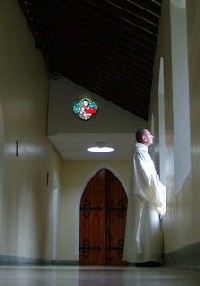 After its birth the Cistercian Order flourished to such an astonishing degree that within a century it included a very large number of monasteries, in all parts of Europe. But inevitably it began to experience the normal alternations between periods of greater fervor and fidelity to the original charism, and on the other hand periods of reduced vitality. This made it necessary to institute vigorous reforms to revitalize the original spirit of the Order. The General Chapter met annually to review the progress of the communities, and to assure the integrity of Cistercian life and the uniformity of fundamental observances.
After its birth the Cistercian Order flourished to such an astonishing degree that within a century it included a very large number of monasteries, in all parts of Europe. But inevitably it began to experience the normal alternations between periods of greater fervor and fidelity to the original charism, and on the other hand periods of reduced vitality. This made it necessary to institute vigorous reforms to revitalize the original spirit of the Order. The General Chapter met annually to review the progress of the communities, and to assure the integrity of Cistercian life and the uniformity of fundamental observances.
Several Popes also interested themselves in the Order’s spiritual progress, two of them going so far as to issue papal bulls which enforced reforms in certain areas. Parvus Fons, issued in 1265 by Pope Clement IV, regulated the governance, while Fulgens sicut stella, issued in the mid fourteenth century by Pope Benedict XII (a Cistercian), dealt with financial management and studies. The General Chapters were charged with putting these reforms into action.

Pope Benedict XII
But due to the Hundred Years’ War (1335-1435), for an entire century the General Chapters were suspended, and during of the Western Schism (1378 – 1417) the monasteries themselves were divided in their allegiance to rival Popes. When the war and the schism ended, the Chapter tried to reach the most far-flung communities in need of reform, by means of Regular Visitations. Particular attention was paid to Northern Europe and to Iberia. In Spain, Martin de Vargas formed a plan for returning to a more austere observance, and to implement this plan, founded the first Cistercian congregation, the Congregation of Castile (1425). The General Chapter also reached out to communities in Eastern Europe, England, Belgium and Flanders.

Oseira
In 1494 Jean de Cirey, Abbot of Citeaux, courageously instituted a plan to revive monastic observance, long debilitated by war, the commendam system (whereby kings took over the selection of abbess or abbot of a monastery), and general mismanagement. The codification of this plan became known as The Articles of Paris. Besides, in the aftermath of the division of Christendom following the Protestant Reformation, and with the rise of nationalism, the monasteries of the Order were gradually dividing into national groups. The congregations that were born in various regions towards the first half of the 1440’s brought back to life a firm desire for rebirth in the Cistercian spirit, but then tended to disappear by the first half of the nineteenth century. These congregations were obliged to adapt their lifestyle to the norms of contemporary reform movements in the Church at large.
During the period of the Congregations all our monasteries underwent great transformations, leaving deep marks of growth in the areas of spirituality, intellect, and community life.
List of major Cistercian Congregations:
- 1425 Martin V: Congregation of Castile
- 1497 Alexander: Congregation of St. Bernard in Italy
In the wake of the Council of Trent:
- 1567 Pius V: Congregation of Portugal
- 1616 Paul V: Congregation of the Crown of Aragon
- 1623 Gregory XV: Roman Congregation
- 1623 Urban VIII: High German Congregation
- 1806 Pius VII: Helvetic Congregation
- 1894 Leo XIII: Swiss-German Congregation
